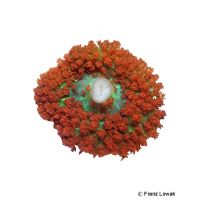Warty Corallimorpharian (Rhodactis osculifera)
| Warty Corallimorpharian Rhodactis osculifera | |
|---|---|
| Name | Warty Corallimorpharian |
| Name Lat. | Rhodactis osculifera |
| Synonym | Discosoma sanctithomae |
| Family | Discosomids |
| Family lat. | Discosomidae |
| Order | Coral Anemones |
| Order lat. | Corallimorpharia |
| Origin | Caribbean Sea |
| Diet | Carnivore, autotrophic |
| pH | 8.1-8.4 |
| Hardness | 6-10 °KH |
| Lighting | Medium |
| Current | Moderate |
| Behavior | Semi-aggressive |
| Keeping | Colony |
| Care Level | Moderate |
| Life Span | N/A |
| Protection | No |
| Metric Units | |
| Size | 5 cm |
| Temperature | 22-28 °C |
| Salinity | 33-36 ‰ |
| Aquarium | 100 l |
| US Units | |
| Size | 2" |
| Temperature | 72-82 °F |
| Salinity | 1.020-1.025 sg |
| Aquarium | 25 gal |
Distribution and habitat
The range of Rhodactis osculifera is the Caribbean, from the Bahamas through Florida and the Caribbean to the Gulf of Mexico. They colonize rocks and dead corals on low-flow reefs.
Maintenance
They should be positioned in a place with medium light intensity and moderate, alternating current. Only lime-rich, heavy metal-free substrates should be used as substrate
To ensure water quality, filters, skimmers and heaters are necessary, as well as pumps to simulate tides, swells and bottom currents
It is recommended that live stones be used to set up the aquarium. The bacteria living in the porous stones act as a biological filter. The lighting must correspond to the species-appropriate day-night rhythm of the animals
| Salinity: 33-36 ‰ | pH value: 8.1-8.4 |
| Carbonate hardness: 6-10 °KH | Nitrate content: 2-8 mg/l |
| calcium content: 400-450 mg/l | Nitrite content: 0.0-0.05 mg/l |
| Magnesium content: 1.250-1.350 mg/l | phosphate content: 0.01-0.1 mg/l |
Regular addition of trace elements, especially iodine, is recommended. For salinity, an average value should be aimed for, which may only vary slightly by +/- 0.5 ‰. Ammonia and ammonium must not be measurable. Special attention shall be paid to consistently good water quality and water values.
Diet
Zooxanthellae, which are unicellular symbiotic algae, live in their tissue and provide them with assimilation products of their photosynthesis (high light requirement). The zooxanthellae promote growth and provide additional food to the plankton and small particles collected from the water current. Accordingly, in addition to the food produced in the aquarium during fish feeding (mysis, krill, Artemia, etc.), commercial food for lower animals in the form of phyto- and zooplankton, frozen or liquid, should be offered regularly
Regular and varied feeding promotes health and prevents deficiency symptoms.
Behaviour and compatibility
They live in large colonies and can be well socialized with fish that do not consider them food. A sufficient distance to other corals must be kept to avoid encrustation.
Reproduction and breeding
Their asexual reproduction occurs by budding or longitudinal division of the polyp. Reproduction by fragmentation is well possible. For this purpose, small stones are placed at the edge of the colony and after their overgrowth the junction is separated
Important
At night they change polyp shape for plankton capture
The additional illumination with actinic light (short-wave, violet-blue light) is very beneficial for their growth (zooxanthellae).
A calcium reactor and a magnesium dosing pump are recommended for the necessary steady supply of calcium carbonate and magnesium. Newly introduced animals must be accustomed slowly to the water in the aquarium
If different species are kept together, care should be taken to ensure that fish and invertebrates match each other in terms of water quality and temperature requirements and their social behavior, and that the setup meets the ecological needs of all species kept together.
Further literature can be found in your pet store.
References
Text: Werner Winter; Image: Alex Rinesch
Source: BAENSCH & DEBELIUS (2006): Meerwasser Atlas Bd. 1, Mergus Verlag; ENGELMANN & LANGE (2011): Zootierhaltung - Tiere in menschlicher Obhut: Wirbellose, Verlag Harri Deutsch
